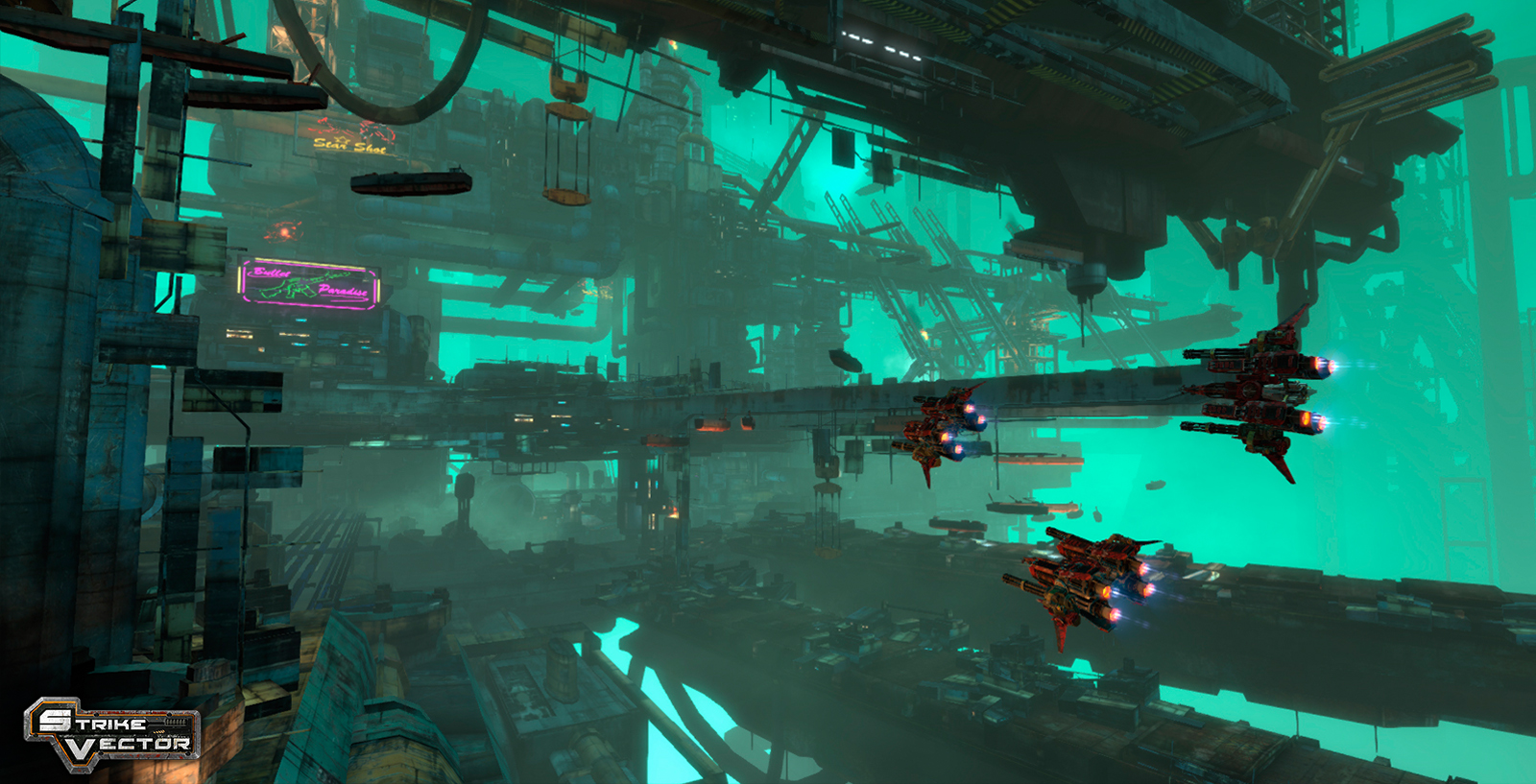Remember the All-Range Mode of Lylat Wars? Battling it out with giant mech bosses but also sat down, leant forward rubbing shoulders with your friend from down the street, staring at the bubble glass window of the colossal, ten-tonne heavy, 22-inch TV. Take that memory and send it seventeen years into the future with a plasma gun on one side, and a carbine on the over, and a barrel roll to avoid a rocket launched by a enemy VTOL (vertical take-off and landing) tearing across the floating slum. And you can only say to yourself, ‘should have barrel rolled?.’
What Ragequit Corporation advertise is an aerial FPS inspired by FPS games such as Quake 3 and Unreal Tournament crossed with a 360 degree aerial shooter.
Patience is key in Strike Vector, as the feel for being able to flick your VTOL around the beautiful environments is something that takes time to get used to but as you adapt it feels intuitive and feel fantastic. A simple press of the spacebar switches between the two modes: Jet-Mode allows you to cover long distances in short spaces of time, moving towards wherever your mouse is pointing like a laser guidance missile.
Stationary Mode, on the other hand, allows you to pivot on the spot - swiveling like the head of a predatory eagle, keeping your back against the space station walls. Flicking between the modes is difference between being hunted or the hunter but more times than not these can be happening at the same time, as the game is online only many players have adapted to the controls and simply picking you out from five-hundred meters away is child’s play to the best.
Don’t let this discourage: kills in this game are incredibly rewarding and deaths never feel like you’ve been cheated. Not many games can make the player feel that they deserved it any shape of form, be that a skilled shot of timing the rocket launcher that perfectly blows the enemy VTOL into the next seventeen years, like colliding your hand to that vampiric mosquito which stole the blood from you, and a death could be just a bad decision such as staying in ‘stationary mode’ for too long.
The vast maps have holes throughout to allow quick, last-ditch escapes. They’re beautifully constructed. The speed at which everything happens means you don’t get more than five seconds to look at the nearest bit of scenery. Some games have used this as an excuse to create lazy textures, but this can’t be seen in Strike Vector. It won’t win awards for being the best but if anything has ever matched the statement ‘Consistency is key’, this is it.
This philosophy is replicated on to the VTOLs which are not made to look sleek; there are no obvious lines of aerodynamics. They closely resemble guns with Jets attached and bigger guns. They don’t look as agile as they are, but these giant chunks of metal do look like they can handle a scrap.
There’s room for some customization, but I’d have liked to see some more. The cockpit and jets can be interchanged as you rank-up and unlock more upgrades but these are merely cosmetic and have no impact; and thus are just left to the players taste along with the icons, patterns and paint colors, which can also be applied to the chassis. The cosmetic upgrades are nice to see as many players like to personalize their appearance: something which is evident in games such as Call of Duty and Battlefield. But a game which is multiplayer-only should allow the user to build VTOLs to their taste of playing styles: whether that be fast and agile, or a brute tank to be able to sustain damage. If we were to reflect on Ragequit’s goals of drawing inspiration from games like Quake 3, then they have been true to their word. Despite this it’s easy to imagine that they could have still kept a balanced game with these changes.
At a competitive price point for a game that is multiplayer only, Strike Vector is a game that should not be ignored. Once you get a grasp of the controls, the next step on the learning curve is your weapons, of which there are eight to choose from - ranging from Gatling guns to swarm missile launchers. Each one requires time and dedication to master, and can be combined with one another so you can head into battle with two different weapons for different scenarios. These are then paired with Special actions - basically a temporary power-up - which have a unique cool-down time and act as get-out-of-jail-free cards, giving the player one chance to strike back at an enemy they can’t escape or evade their reach entirely.
Passive skills act as a final touch to the players war chest. These perks help survival, offering increased defense, or allowing you to see an enemy for a brief amount of time when he goes behind cover. Creating an efficient and deadly combination makes a big difference, allowing players to truly craft a unique and effective killing machine.
Strike Vector is a fantastic offering by nine Indie creators in France. Ragequit Corporation deserves a pat on the back; they’ve offered an alternative to the usual staid fare and deserve to be rewarded. More customization options would have been nice, but we’re yet to see the free DLC that they have to offer. If the quality on show so far is anything to go by, it should be worth the wait.


